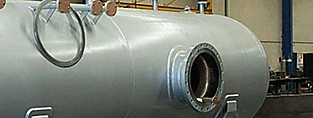
- (03) 5909 8218
- enquiry@fusionweld.com.au
What is Condensing Tankless Water Heaters?
April 28, 2017

Let's take a walk through tankless water heater territory. As the term implies, the design ousts its storage tank in favour of an advanced engineering solution. In its place, a heat exchanger and coiled pipes establish a thermal transaction effect. It's obviously an innovative design, one that increases operational efficiency. Condensing tankless water heaters further augment this operational principle, but how do they achieve this impressive engineering goal?
What is a Condensing Water Heater?
Everyone recognises a water heater when they see one. It's the boiling vessel that throws off wisps of hot steam. It's insulated to prevent such losses, yet they still manage to seep through tiny gaps. Tankless water heaters sidestep this issue by employing heat exchanger technology instead of a static storage vessel. As for the prefacing "condensing" descriptor, this added functionality extracts more thermal energy from the heating circuit by adding a secondary heat exchanger to the equipment. In effect, the condensate generated by the primary circuit is funneled into a thermal reclamation unit, which is where this secondary unit enters the process line.
Adding Heat Transference Components
A number of supplementary components act as system channels in this design. These are the metal manifolds and welded heat transfer tubes that encourage condensate conveyance. Without this mechanism, the primary heat exchanger would vent the state-changed vapour. The condensate assembly avoids venting by redirecting the evaporated leftovers into the secondary heat exchanger. The thermal reclaim then returns to the primary stream to elevate system performance. Still, the incorporation of a robust condensation unit isn't quite as easy as it sounds. Imagine an interior stage that's loaded with corrosive vapour, the type of gases that would cause metal fatigue in many treated steel assemblies. The rechanneled vent gases must be funnelled into the secondary heat exchanger, so special corrosion-proof alloys are required. A rust-resistant metal just won't satisfy the material design specs on this occasion, so a corrosion proof alloy must be installed.
A condensing tankless water heater elevates the performance of this already energy efficient design. The compact unit, freed from its loss-prone storage tank, introduces an extra heat exchanging stage. That supplementary unit then combines with specially mounted heat transference tubes to extract any remaining energy, the heat that would otherwise be vented as a condensation stream. Built to deliver a superior thermal transference rating, this equipment may require heat treated alloys to withstand the fatigue-inducing hot gases, but the recovered energy makes this long-term investment a worthy addition to any budget-conscious heating network.
Contact Details
Fusion - Weld Engineering Pty Ltd
ABN 98 068 987619
1865 Frankston Flinders Road,
Hastings, VIC 3915
Ph: (03) 5909 8218
Optimized by NetwizardSEO.com.au
Recent Posts
- Heat Exchanger Maintenance in Melbourne: Minimising Risk in Power Generation Facilities
- Compressed Hydrogen Storage Vessels: Material Selection, Design & Australian Standards
- Welding QA/QC in Oil & Gas Pressure Vessel Fabrication – Ensuring Code Compliance
- AS1210 vs ASME VIII Pressure Vessel Code: Key Differences for Australian Projects
- Mitigating Hydrogen-Induced Cracking in Pressure Vessels: Engineering and Material Strategies
- Storage Tank Solutions Australia: Field-Erected, Prefabricated & Self-Bunded Explained
- Reducing Environmental Risks: Self-Bunded Tanks in Australian Oil & Gas Operations
- Precision in Production: How Pressure Vessels Are Manufactured for Industrial Safety
- Shell & Tube Heat Exchangers: Improve Thermal Control & Energy Recovery in Petrochemical & Pharmaceutical Plants
- In-Service Inspection for Compressed Air Receivers for Power Plant Shutdown Prevention
- Power Plant Pipe Spooling Fabrication – Get Rapid, Code-Compliant Spools Ready for Installation
- Field Erected Tanks: Safe, Reliable On-Site Fuel Storage Solutions in Australia
Posts 2026
- Heat Exchanger Maintenance in Melbourne: Minimising Risk in Power Generation Facilities
- View all articles…
Posts 2025
- Compressed Hydrogen Storage Vessels: Material Selection, Design & Australian Standards
- Welding QA/QC in Oil & Gas Pressure Vessel Fabrication – Ensuring Code Compliance
- View all articles…
Posts 2024
- Large Process Vessels: Optimising the Design for Maximum Efficiency [2025]
- Pressure Equipment Management System Installation: Detect Equipment Faults Early
- View all articles…
Posts 2023
- Pressure Piping System Inspection: A Gift of Safety for the Holidays
- Deaerator Inspections by Fusion-Weld Engineering and How They Reduce System Downtime
- View all articles…
Posts 2022
- How Fusion Weld Keeps Up With AS-NZS ISO 9001:2008 Standard
- Boiler Equipment Safety Inspection During the Summer Season
- View all articles…
Posts 2021
- Avoid These Factors and Practices that Contribute to Sealing Damage in Pressure Vessels
- Do's And Don'ts Of Industrial Boiler Inspection And Maintenance From Fusion-Weld
- View all articles…
Posts 2020
- What are the Risks and Hazards Involved in Pressure Vessel Equipment?
- How to Know if Your Pressure Equipment Needs Repair or Replacement?
- View all articles…
Posts 2019
- Factors that Contribute to Pressure Vessel Failure
- Pressure Vessel Regulations in Australia: What are the Mandatory Requirements?
- View all articles…
Posts 2018
- Pros and Cons of Spherical vs. Cylindrical Pressure Vessels
- What are the Different Hazard Levels in Pressure Vessels?
- View all articles…
Posts 2017
- Transportable Pressure Vessels: The Importance of Inspection and Safety Checks
- Fracture Mechanics and Stress Analysis of Cracks in Pressure Vessels
- View all articles…
Posts 2016
Posts 2015
- What Are Deaerators & Feedwater Vessels?
- Precautions and Safety for Compressed Air Receiver Vessels
- View all articles…
Posts 2014
- Demonstrating In-process Inspection Procedures
- Static Grounding Practices and Standards
- View all articles…